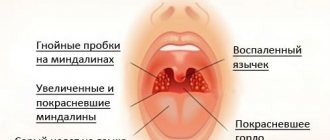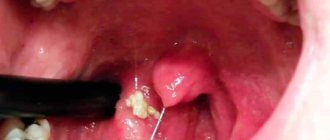The nasopharynx is considered a barrier against various bacteria, viruses, and dust particles. When a person is infected with pathogenic microorganisms, it is the first to signal the pathology and begins to fight it. This is how swelling of the nasopharynx appears, which can be caused by various diseases, for example, allergic rhinitis, sinusitis, runny nose and other diseases.
The patient may be bothered by nasal congestion, dry mucous membranes, burning, soreness in the nose and throat. Therapy for swelling of the nasopharynx should be aimed at eliminating the factor that caused it, therefore, when the first symptoms of this pathology are detected, you need to consult a specialist.
Causes of nasal swelling without a runny nose
The main causes of swelling of the nasopharynx are considered to be colds - they are the initial factor in the formation of edema. Due to these pathologies, in addition to the main symptom, there is weakness, malaise, headache, nasal congestion, and only a few days after the onset of a cold, mucous discharge may occur.
In addition to the common cold, the following factors can be identified:
- nasal polyps,
- changes in hormonal levels,
- abnormalities in the development of the nasopharynx,
- long-term use of drugs,
- injuries.
The formation of polyps or adenoids in the nasal cavity also contributes to the occurrence of edema - with their development, as a rule, noticeable nasal congestion is observed, the mucous surface gradually swells, but a runny nose is often absent.
Changes in hormonal levels can also affect the development of this condition - the nasal mucosa can swell in women during pregnancy, which is associated with changes in the body.
Congenital anomalies associated with the development of the nose are often the cause of swelling, this can be a deviated nasal septum and other birth defects.
Irrational use of nasal drops is also an important cause of swelling; if the adequacy of taking vasoconstrictors is impaired, drug addiction may develop, which causes congestion, breathing problems and swelling of the nasopharynx without a runny nose.
Traumatization of the nasal cavity or septum - also accompanied by swelling, this can be:
- blows,
- bruises,
- fracture, fracture
- entry into the nasal passages of a foreign body, which will disrupt the structure of the mucous membrane and cause its swelling.
Signs of swelling of the nasopharynx
The main symptom of this pathology is nasal congestion. Other manifestations of edema in the nasopharynx depend on the reasons for their occurrence.
Allergic edema is accompanied by the following symptoms:
- violation of free breathing through the nose;
- frequent sneezing;
- rashes on the skin;
- discharge of mucus from the nostrils;
- burning sensation in the throat.
Swelling caused by injury has the following manifestations:
- nasal congestion with and without mucus formation;
- snoring at night;
- pain in the nasopharynx;
- inability to breathe freely through the nose.
Reference! When a foreign body enters the nasal passages, the victim feels pain and congestion only on the side of the injury.
Manifestations of this pathology in colds caused by viruses and bacteria are as follows:
- nasal congestion;
- copious clear mucous discharge, in some cases with pus;
- the appearance of pain in the ears and nasopharynx;
- weakened condition and increased body temperature;
- voice change;
- cough;
- upon examination, swelling of the posterior wall of the nasopharynx is observed;
- impaired sense of smell.
With adenoiditis, swelling of the nasopharynx is accompanied by the following symptoms:
- constant night snoring;
- severely difficult nasal breathing;
- decreased hearing acuity;
- nasality;
- constant runny nose.
This pathology can also occur with mucous discharge. This condition can occur with the formation and growth of polyps, adenoids, hormonal imbalances, anatomical pathologies, long-term use of drops with a vasoconstrictor effect, dry air in the house, or in the first days of a cold or flu.
Attention! If you detect any of the above symptoms, you must seek advice from a specialist who will establish the correct diagnosis and prescribe treatment.
Other factors that provoke swelling of the mucous membrane
Swelling is also influenced by bad environmental factors; they can also cause diseases of the nasopharynx. The cause of nasal swelling may be excessive dryness of the air in the room, as well as high humidity, which also negatively affects the condition of the mucous surface.
An allergic reaction is also a common cause of swelling of the nose and nasopharynx. Due to allergies, nasal congestion is noted and breathing becomes difficult. Additional signs include sneezing, watery eyes, and discomfort in the nose.
Poor diet - can cause nasal swelling, especially if you eat too much sugar. It tends to be deposited in the body and provokes a disruption in hormonal levels, which causes swelling of the nasopharynx.
Causes of swelling
Under the influence of negative factors, edema may develop. The main causes of nasal swelling are the action of pathogenic microorganisms. Their contact with mucous tissue causes vasodilation, which causes swelling, accompanied by a deterioration in the patient’s condition.
Factors in the development of this pathology may also include:
- vegetative-vascular dystonia;
- alcohol abuse;
- chronic diseases;
- colds.
The risk group includes diabetics and patients with reduced immunity. A person learns about the problem by the fact that his nasopharynx is blocked. In order to eliminate it, a diagnosis must be made. Only in this way will therapeutic methods be effective and ensure recovery.
Pharyngitis
Nasopharyngeal congestion and swelling of the mucous tissues often occur with pharyngitis. Lymph nodes and mucous tissues are damaged. It appears against the background of respiratory tract diseases. People over 30 years of age are most prone to developing pharyngitis.
The similarity of symptoms with other diseases complicates diagnosis. Therefore, pharyngitis is recognized in the later stages, when swelling affects the posterior wall of the nasopharynx.
The disease has the following symptoms:
- inflammation of the mucous membrane;
- the appearance of purulent discharge;
- dryness and sore throat;
- enlarged lymph nodes;
- weakness appears.
Pharyngitis is treated with medication, but if it does not help, then the patient undergoes surgery. During surgery, the affected mucosa is cauterized using cryodestruction or laser. The choice of therapeutic method depends on the patient’s condition and the cause of the pathology.
We recommend additional reading: How to quickly remove swelling from the eyes: causes and treatment
Rhinitis
A common cause of problems with the nasopharynx is rhinitis (runny nose). The pathology is manifested by nasopharyngeal congestion and the appearance of nasal discharge. It can occur for various reasons: hypothermia, under the influence of allergens, bacteria. The first symptoms are a serious reason to undergo a medical examination.
Under the influence of pathogenic microorganisms, the function of the nasal mucous tissues is disrupted. Such negative changes lead to poor circulation and blood stagnation. The patency of the nasal passage decreases, breathing becomes difficult. The development of inflammation of mucous tissues has clear clinical symptoms; the features of the clinical picture make it possible to establish an accurate diagnosis without any problems.
Often a runny nose is of an allergic nature. Allergic rhinitis comes in different types (seasonal, year-round). People with hypersensitivity to certain substances experience allergic swelling.
Allergic
Swelling of the nasopharynx occurs as a result of allergies in every tenth person. It is this that leads to the most dangerous consequence in the form of Quincke's edema. This can be a reaction to animal fur, fluff and plant pollen. The problem also occurs after contact with household dust.
Allergens enter the body through inhalation or through food. Many organs signal a problem, but most often the pathology is manifested by redness and swelling of the mucous tissues. This is due to the fact that the mucous tissues of the nose are the first to be exposed to allergens.
In order to determine whether the swelling is caused by an infection or an allergy, it is necessary to undergo an examination and take a blood and urine test. After making a diagnosis, the doctor will select treatment methods and tell you how to deal with the problem.
Allergic swelling is characterized by stenosis of the mucous tissues of the nasopharynx. The pathology develops at lightning speed and is accompanied by loss of voice. Then oxygen starvation, asphyxia and death occur.
Timely identification of the cause of the problem will allow the problem to be completely eliminated.
Swelling without runny nose
Swelling is not always accompanied by rhinitis. Sometimes swelling of the nasopharynx appears without a runny nose. The main reason for its development is vasodilation. It is provoked by viruses that enter mucous tissues. Dry air can also cause the problem. Regardless of the reasons for the development of the pathology, all patients experience redness of the nasal mucosa and impaired respiratory function.
If left untreated, inflammation begins, erosions and cracks appear. Sometimes it is enough to regulate the level of air humidity and the unpleasant symptoms will go away on their own.
We recommend additional reading: How to get rid of swelling, paint bags or sufas on the cheekbones of the face
For a cold
Swelling can be caused by various colds. Among them, ARVI and influenza are the most common. Swelling of mucous tissues appears in the first days of a cold or flu. It makes breathing difficult and aggravates the general condition.
The danger is not only that a person constantly feels congestion in the nasopharynx. Because even after recovery, swelling can persist. Sprays and drops are not able to help and only temporarily alleviate the condition. In this case, congestion becomes a constant companion, and the person always feels that his nasopharynx is blocked.
Sometimes sinusitis develops, in which patients collect pus in the cavities of the maxillary sinuses. To prevent such a situation, when the first signs of pathology appear, you should see a specialist and, with his help, select effective methods of therapy.
Traditional treatment
Treatment of nasopharyngeal edema must be started promptly after a full diagnosis. For a better therapeutic effect, the cause of swelling should be established, the condition of the mucous membrane should be assessed, and additional symptoms should be identified.
Most often, as a traditional treatment for swelling and redness of the mucous membrane, the following are prescribed:
- medicines,
- inhalations,
- washing solutions.
Antibiotics
If the cause of swelling is an infectious pathology, the patient is prescribed antibacterial drugs that suppress the activity of pathogenic flora and contribute to its destruction. Antibiotics should be taken only as directed by a medical specialist, since these medications have a significant list of contraindications and side effects.
Nasal drops and antihistamines
Nasal swelling can be reduced with the help of vasoconstrictor drops and the use of antihistamines. The most popular treatments for this disease are:
| Drugs | Photo | Price |
| Tizin | From 99 rub. | |
| Suprastin | From 133 rub. | |
| Diazolin | From 66 rub. |
Wash solutions
With the development of adenoids, the patient is prescribed saline solutions and inhalation measures. In addition, nasal vasoconstrictor drops and silver-based products are also used.
During the period of bearing a child, you can fight nasal congestion with the help of saline solutions, which help safely relieve swelling and improve nasal breathing. In case of severe swelling, the patient may be prescribed vasoconstrictor drops, but this is quite rare because they are undesirable during pregnancy. Self-administration of these drops is strictly contraindicated; this should only be done as directed by a doctor.
Visit to a traumatologist
If the cause of swelling is an injury to the nose, septum, or another area of the nose, you should seek help from a traumatologist. Depending on the condition of the injury, he may apply a regular bandage or plaster.
Pathogenesis of the disorder
Air enters the human body through the nasopharynx, first being warmed, moistened and cleansed of pathogenic bacteria.
If pathogens enter the nasal mucosa, the body becomes involved in the fight against them, and blood circulation is activated. Thanks to intensive blood circulation, the blood vessels expand and their permeability increases. With edema, there may be a slight secretion of mucus from the nasal passages, but often the mucous membrane remains very dry. Upon examination, the doctor can see that the mucous membrane has become dense and inflamed. In rare cases, discharge of pus is noticeable.
Depending on the symptoms of the disease, the doctor determines the exact cause that led to the swelling. Treatment in this case is aimed not only at eliminating edema, but also at treating the underlying pathology.
Traditional methods of treatment
If the nasal mucosa swells, in addition to the traditional method of treatment, traditional medicine is widely used. It includes a large number of universal recipes and is as effective as medicine in combating swelling of the nasopharynx.
Popular methods of home therapy are inhalations, warm baths, and solutions based on medicinal plants. Alternative treatment should be used after consultation with a doctor to avoid unwanted consequences.
Inhalations
Inhalation is an effective treatment; with this method, a person can improve nasal breathing, relieve swelling and existing congestion. The following can be used as raw materials for preparing the solution:
- chamomile,
- calendula,
- sage and so on.
To prepare a medicinal solution, pour boiling water over a small amount of medicinal plants and let it brew. Afterwards, the mixture is filtered, cooled and the nasal passages are washed.
Thuja oil
Thuja oil is a wonderful remedy that has an antiseptic effect. Effectively fights adenoids and polyps, helps normalize the mucous surface and helps strengthen the immune system. The oil should be instilled into the nose daily, 1-2 drops.
Dry heat
Dry heat is also used to reduce swelling of the nasopharynx. To do this, apply to the partition:
- warm salt,
- boiled egg,
- use a blue lamp.
You can warm your nose no more than once during the day.
Treatment with folk remedies
If the swelling of the airways is traumatic in nature, contact a traumatologist. In other cases, see an otolaryngologist. But treatment of swelling of the nasal mucosa with medications does not always produce the desired effect or can be indicated for the patient. In such cases, old recipes and time-tested folk remedies come to the rescue.
Folk recipes
The main folk methods for relieving airway congestion syndrome are considered to be rinsing, inhalation and instillation. Nasal drops and inhalations are indicated for any manifestations of nasopharyngeal congestion.
As for saline rinsing, it is not indicated for all patients, since it can relieve swelling of the nose during a runny nose, but rinsing is not recommended for dry congestion. A hypertonic solution will only worsen the dryness of the nasopharyngeal mucosa.
Inhalations
- Essential oil of fir, pine or cedar. Add 3-4 drops of any essential oil to a wide saucepan with boiling water. Lower your face to the surface of the water, cover yourself, and inhale the vapors for 10-15 minutes, two or three times a day.
- Boiled potatoes. Boil 3-4 potatoes “in their jackets”, drain the water completely, break the tubers, bend over, cover, and breathe in the vapors from the potatoes until they cool down.
Burying
- Beetroot juice. Grate the raw root vegetable on a fine grater and squeeze. Mix freshly prepared juice with boiled water in a 1:1 ratio and instill three drops into both nostrils three times a day. Not recommended for children to avoid burns to the mucous membranes. They don't store it. Fresh drops are prepared daily.
- Aloe leaf juice. To prepare the drops, use the leaves of a plant that is at least three years old. Cut off the bottom leaf, rinse and grind in a meat grinder or blender. Squeeze out the juice, mix with the same amount of bee honey, and instill 2-3 drops into both nostrils five times a day.
- Bee Honey. Mix a tablespoon of unheated honey well with the same amount of boiled water. It is recommended to instill 4-5 drops of honey solution 3-4 times a day.
- Sea buckthorn oil. To relieve the inflammatory process that occurs without a runny nose, and with general dryness of the nasopharynx, it is recommended to drip two drops of pharmaceutical sea buckthorn oil into each nostril.
Onion juice infusion
Grind one medium-sized onion and mix with cooled boiled water in the following ratio - 3 tbsp. l. pour 1 cup of onion pulp. water. Add 1 tsp to the mixture. bee honey, stir and leave for 45-60 minutes.
The infusion can be used for rinsing or as nasal drops. This onion juice tincture can also be used as an optimized measure for the prevention of influenza and ARVI in children. To increase the effectiveness of the product for adults, you can reduce the volume of water by half. But in this case there is a risk of burning the mucous membrane.
Herbal decoction for rinsing
Mix an equal amount of chamomile and calendula. 1 tbsp. l. Pour boiling water over the mixture and place in a water bath for 20-25 minutes. Cool the broth and strain before use. By the way, this decoction can be used in the combined treatment of adenoids in children.
Treatment of nasal swelling in young children
In childhood, as well as in adults, there are many reasons due to which swelling of the nasopharynx can develop. The most common are:
- allergic diseases,
- chronic runny nose,
- infectious processes,
- development of adenoids or polyps,
- various nasal injuries.
Based on the reasons, the small patient is prescribed competent therapeutic intervention. Medicines are often used as treatment. However, their choice should be approached with particular care, since many of them are contraindicated for use at a young age.
Redness of the mucous membrane and its swelling should be treated only after a full diagnosis and examination of the child by a medical specialist. According to the etiology, individual characteristics of the body and age, he will select the right remedy that will be the safest for the little patient.
During the initial stages of therapy, in no case should you treat the child yourself, give him antibiotics, vasoconstrictor drops and rinse the sinuses with a pear-shaped balloon.
Features of pathology in children
Adults tolerate swelling of the nasopharynx much easier.
Than little kids. If treatment is not started in time, swelling of the nasopharynx in a child can lead to serious health problems. Especially often the inflammatory process involves the Eustachian tube. As a result, the child’s hearing is impaired or completely lost. The risk of serious complications in young children is very high. This can be explained by the fact that the immune system of babies is very weak and is not able to cope with infections. This factor is also associated with a very high temperature in children with swelling of the nasopharynx. If in adults it does not exceed 38 degrees, then in children it can reach 39.5, which is very dangerous for the life of a child .
If a bacterial infection occurs, then purulent discharge from the nasopharynx can enter the bloodstream, which will lead to sepsis or meningitis.
Prevention
The development of swelling in the nasal area can be prevented by following certain preventive recommendations:
- Timely treatment of infectious and colds in children and adults.
- Do not overdo it with the use of vasoconstrictor drops.
- It is important to increase and strengthen the immune system with the help of a balanced diet, hardening, and hypothermia should be avoided.
- It is necessary to prevent the impact of allergens on the body in the presence of an allergic disease.
- It is advisable to undergo regular examinations to identify adenoids and polyps, and if they appear, eliminate them in a timely manner.
Swelling of the nasopharynx: symptoms, causes, diagnosis, treatment
A swollen nasopharynx, excessive redness of the facial skin, sneezing and a runny nose are a completely natural reaction of the body to viruses coming from outside. But they require immediate treatment.
In fact, swelling of the nasopharynx in a child and an adult is a pathological condition caused by various diseases. It is noteworthy that after some time the swelling itself can lead to no less serious complications. This symptom requires a more careful attitude towards yourself.
Symptoms of nasopharyngeal edema
The mucous membrane of the nose and pharynx seems to be lined with a special tissue that consists of ciliated cells. Their main function is the slow movement of particles that enter the nose with the outside air. Due to the influence of certain factors, a change in the functions of these cells can occur, which causes edema.
Infectious agents entering the respiratory tract will significantly increase the permeability of the vessels located here. But this is exactly what is needed to fight pathogenic microbes. There is an increased flow of lymph and blood to the nasopharynx, which causes the development of not only swelling, but also inflammation.
Simply put, the mucous membrane is a kind of barrier that effectively delays infection and prevents it from entering the body, as well as surrounding organs. Swelling of the nasopharynx indicates the beginning of the body’s struggle with any damage or elements that have entered it, causing a reflex reaction.
Hormonal disorders
It has been proven that swelling of the nasopharynx in some cases can also be caused by hormonal disorders, which is especially common for pregnant women. The reason for this is the excessive secretion of the hormone progesterone, which should support normal pregnancy. It is noted that women who have sinusitis have increased levels of hormone production.
Inflammation
Inflammatory processes that lead to swelling of the nasal mucosa usually occur as a result of prolonged hypothermia. Thus, prolonged exposure to the cold, especially without a hat and scarf, as well as exposure to cool water can threaten the health of the nasopharynx. The next cause of inflammation is considered to be regular consumption of cold liquids and food.
Adenoids
The nasopharynx may swell in childhood due to adenoids, in which hypertrophy of the nasopharyngeal tonsil is noted. Children may also experience frequent colds, weakened immunity, and a lack of essential vitamins and microelements.
Injuries
Swelling of the nasopharynx, which appears after injury, is perhaps a natural reaction for the body. Due to mechanical trauma, the integrity of the mucous membrane is violated, as a result of which the protective systems will compensate for the deficiency.
The size of the swelling, as well as the time it takes to get rid of it, will directly depend on the general condition of the person and the severity of the injury. If a person has high immunity, his tissue regenerative qualities will be higher. But, for example, in diabetics, bruises and wounds will take much longer to heal.
Symptoms of edema
Swelling of the nasopharynx can be noticed simply by taking a good look at the nose. It usually has a swollen appearance with redness. But it is not always possible to examine everything in detail, so swelling is characterized by difficulty breathing, a persistent feeling of stuffiness and heaviness in the sinuses.
Viral or respiratory diseases, which often cause swelling of the pharynx and nose, may be characterized by the presence of copious greenish discharge, which, however, may not have a pathological color, as well as elevated temperature and muscle pain. Usually the nose is completely blocked, there is a feeling of dryness, profuse tearing is noted, and it is practically impossible to breathe normally.
If the nasopharynx swells due to infection, the patient may experience heaviness in the sinuses, in the center of the forehead and in the wings of the nose. The victim becomes irritable, quickly fatigues, and is in a broken state.
Pus gradually flows out of the nose, having a yellowish or green color, and often has an admixture of a small amount of blood and a rather specific smell, which the patient, however, may not feel. After some time, some of the pus may break through the membrane, ending up in other parts of the head.
If swelling of the nasopharynx is caused by a deviated septum, the presence of a tumor or injury, then, as practice says, there may be no discharge. However, breathing problems, congestion and heaviness in the throat and nose will persist.
Other symptoms accompanying swelling are:
- dysphonia (changes in timbre, strength and pitch of the voice);
- development of neurovegetative, hormonal, atopic or allergic rhinitis;
- redness of the facial skin;
- frequent sneezing;
- pressure in the area of the nasolabial triangle and bridge of the nose.
Consequences
If a bacterial infection is associated with swelling of the nasopharynx, the patient may develop purulent inflammation. Due to the possible breakthrough of pus and its entry into surrounding tissues, the following rather dangerous conditions may develop:
- trigeminal neuritis;
- osteomyelitis of the jaw;
- atrophy of the nasopharyngeal mucosa;
- meningitis;
- inflammatory process of the optic nerve;
- brain abscess.
Diagnosis of edema
Diagnostic measures for swelling of the nasopharynx consist of the following procedures: laboratory and instrumental examinations, as well as physical examination. Upon palpation, the doctor may detect pronounced edematous and infiltrative changes in the nasopharynx. As directed by the doctor, the patient may be prescribed additional diaphonoscopy or fluoroscopy.
Instrumental methods for diagnosing this type of edema are fiber endoscopy, microrhinoscopy, as well as posterior and anterior rhinoscopy. Laboratory diagnostics consists of examining secretions flowing from the nasal cavity, which involves the use of immunological, cytological, biochemical and bacteriological examination methods.
Treatment of edema
There are several ways to relieve swelling of the nasopharynx. The doctor chooses a treatment regimen for each patient individually, depending on the cause of this pathology. For nasal congestion, Aquamaris, Nazivin or Naphthyzin drops are prescribed. However, it is worth knowing that these drugs only slightly relieve symptoms and do not eliminate the cause of the runny nose.
If inflammation of the nasopharynx occurs due to a viral infection, the most effective anti-allergic and anti-inflammatory effects may have the drugs Cromoglin and Cromohexal, Xylometazoline.
In order to relieve swelling as quickly as possible, you should take antihistamines: Tavegil or Diazolin. Also effective is the Euphorbium compositum spray, which is also homeopathic. At the beginning of the disease, it should be used every 20 minutes.
There are cases when a viral infection is associated with swelling of this organ; in addition to homeopathic and antiallergic drugs, the antiviral “Grippferon” is prescribed. It is preferable to treat the skin areas near the nose with ointments made from essential oils.
If treatment is not started in a timely manner, a person may develop pathological, excessive swelling of the nasopharynx, prolonged rhinitis, and signs of sinusitis. It is very important to rinse each nasal passage with normal saline solution, but not while lying down.
After this, the nose must be treated with an antibacterial agent (Chlorhexidine, Miramistin or Isofra) - this will make it possible to stop the further spread of the infection, as well as prevent the development of more dangerous sinusitis.
Octenisept is also effective in treating nasopharyngeal edema, which allows you to get rid of viruses, microorganisms and bacteria. Since this drug is irritating to the nose and throat, it must be diluted with saline solution.
If a person does not have allergic reactions, it is recommended to treat the nose with herbal decoctions - St. John's wort, eucalyptus and chamomile - powerful natural antibiotics. For more prolonged swelling of the nasopharynx, the otolaryngologist prescribes hormonal medications. They cannot be taken without a doctor's prescription.
Does the patient have swelling of the nasopharynx, narrowing of the anastomosis of the accessory sinuses, as well as the auditory tube? Modern antiallergy drugs, which are usually prescribed by a doctor, are designed to block histamine receptors. They make it possible to remove swelling from the nasopharynx. New generation antihistamines have a more targeted and effective effect.
Causes
In addition to allergies, injuries and infections, other factors can cause swelling in the nasopharynx. For example, severe systemic diseases that cause degenerative processes throughout the body. Unfavorable environmental conditions also negatively affect the condition of mucous membranes.
The reasons causing the violation include:
- hormonal imbalances (during pregnancy, swelling without a runny nose is often observed);
- inhaling too dry air;
- work in dusty rooms, hazardous enterprises;
- sudden climate change;
- diabetes;
- vegetative-vascular dystonia;
- the presence of foreign bodies in the nasal passages;
- alcohol abuse, smoking;
- congenital anomalies of the structure of the nose;
- overheating or hypothermia;
- benign and malignant neoplasms in the nose.
Features of treatment
Rinsing will speed up recovery.
At the first unpleasant sensation, the question arises: how to remove it? It is not possible to cure swelling alone; treatment is aimed at removing symptoms.
For swelling of the nasopharynx, local treatment with medications is used. If breathing is difficult, use vasoconstrictor drops. Do not allow the mucous membrane to dry out.
Rinsing will help relieve pain in the larynx and facilitate the removal of thick mucus from the tonsils. If there is no fever, apply warm compresses to the nose and throat. Physiotherapy in the clinic helps a lot.
Remember, any treatment should be accompanied by plenty of fluids. It’s great if these are fortified drinks that will enrich the body with useful elements and speed up recovery.
Swelling of the nasopharynx in a child
The causes of swelling of the nasopharynx in a child are in many ways similar to the causes of this disease in adults. The following factors can cause this reaction in children:
- Allergy. It can be caused by various substances and foods.
- Physiological runny nose. It occurs in infants, whose mucous membranes have not yet had time to adapt to external conditions.
- Infections. Most often, colds in children are viral in nature, but they can also be caused by bacteria.
- Polyps and adenoids.
- Injuries. The most common injury in children is foreign bodies entering the nasal passages.
When treating swelling of the nasopharynx in a child, you need to pay attention to the instructions, because many drugs are contraindicated for young children. In addition, in children the disease can develop quickly and lead to complications, so it is advisable not to delay contacting a doctor. Some traditional medicine should also not be used when treating children, as they can cause an allergic reaction or adversely affect the baby’s health.
When starting treatment for swelling and nasal congestion in a child, you should remember that the following methods cannot be used:
- drip mother's milk into the nose;
- use antibiotics without a doctor’s prescription;
- drip essential oils into the nose;
- rinse the nasal passages using a rubber bulb or a syringe without a needle, because this can lead to the development of otitis media;
- use vasoconstrictor drops for longer than five days.
If symptoms of the disease persist for more than three days or the child’s condition worsens, you should call a doctor and follow all the recommendations he gives.
Similar articles:
Allergic rhinitis in children
Nasal drops for children
Inflammation of the nasopharynx
Sinus diseases
Inhaler for runny nose
Swelling of the nasopharynx is a symptom that can signal the development of a whole range of otolaryngological or allergic diseases. Let's try to figure out what causes this pathology and what measures can be taken at home in order to cope with its manifestations.









